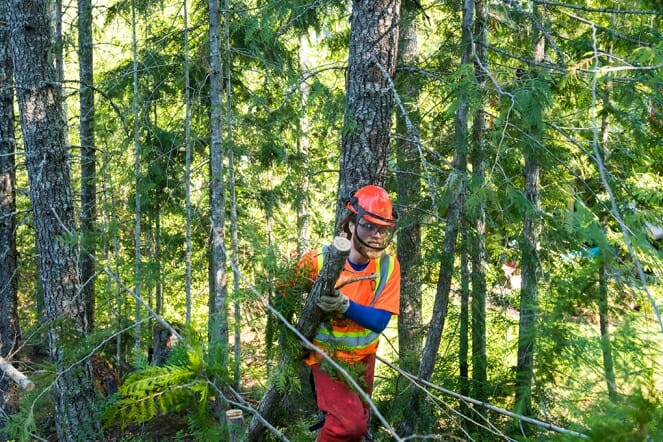The public is asked to obey signage and trail closures in project areas
This spring, the Resort Municipality of Whistler (RMOW) will resume fuel thinning in priority areas that have been identified as having an increased risk of wildfire.
Fuel thinning focuses on leaving mature and deciduous trees, while removing ground brush and debris, pruning lower branches, and removing tight second-growth trees to help reduce the risk of wildfires.
2022 treatment areas include:
- Riverside (Cheakamus Crossing);
- Taluswood; and
- Rainbow areas.
The priority areas are identified for treatment in the RMOW Wildfire Program 2019-2027. Developed by Registered Professional Foresters (RPF), Whistler’s multi-year Wildfire Program identifies wildfire risks within and surrounding the community and recommends priority areas for treatment to reduce the wildfire risk. Once treatment areas have been finalized, a prescription is developed by an RPF, taking into special consideration ecologically sensitive areas and habitats.
“Fuel thinning is an important tool that effectively limits the spread of wildfire,” explained Mayor Jack Crompton. “As climate change advances, it’s critical that we take these measured steps to protect our community members, infrastructure, and ultimately our economy.”
Fuel thinning is scheduled to begin in April as snowpack allows, and will continue through the summer pending appropriate fire danger ratings, with an aim to complete in autumn 2022.
Fuel thinning requires the operation of heavy machinery and tree falling, creating a potential risk to the public. Trails within the treatment areas will be closed during operations and rehabilitated upon completion. Heavy machinery will be used onsite and will only be operated within permissible hours of the RMOW’s Noise Bylaw. Wood chips will be removed and provided to the Callaghan composter. In some instances, chips may be burned on site. Venting Index Regulations will be followed to promote rapid smoke dissipation.
Signs will be posted on the perimeter of active fuel thinning areas. Please obey all signs and wildfire crew instructions. Work will stop if the fire danger rating reaches extreme and will resume when the rating goes down.
Importance of Fuel Thinning
There is a significant risk of large-scale wildfire within the Sea to Sky Corridor due to the proximity of recreational trails and increasingly longer, drier summers. Fuel thinning helps to limit fire growth, reduce fire severity, and aids in fire suppression efforts. This work reduces the risk of fire ignition and spread into the tree canopy by changing forest and fuel characteristics. Thinning trees in dense second-growth forest areas encourages less flammable vegetation to grow on the forest floor while reducing the amount of fuel available that could increase fire intensity and spread.
Fuel thinning also promotes ecological balance by removing dense, unmanaged second-growth trees and leaving the healthiest, oldest, and largest trees untouched. Before treating areas, rare or endangered vegetation is identified and bird surveys are conducted.
Removing accumulations of forest fuels:
- helps reduce the severity and spread of any future wildfires in the area;
- helps prevent a wildfire from spreading into the tops of trees;
- reduces wildfire threats to the community; and
- gives firefighting crews better access to any future wildfire in this area.
For more information, visit whistler.ca/FuelThinning.

